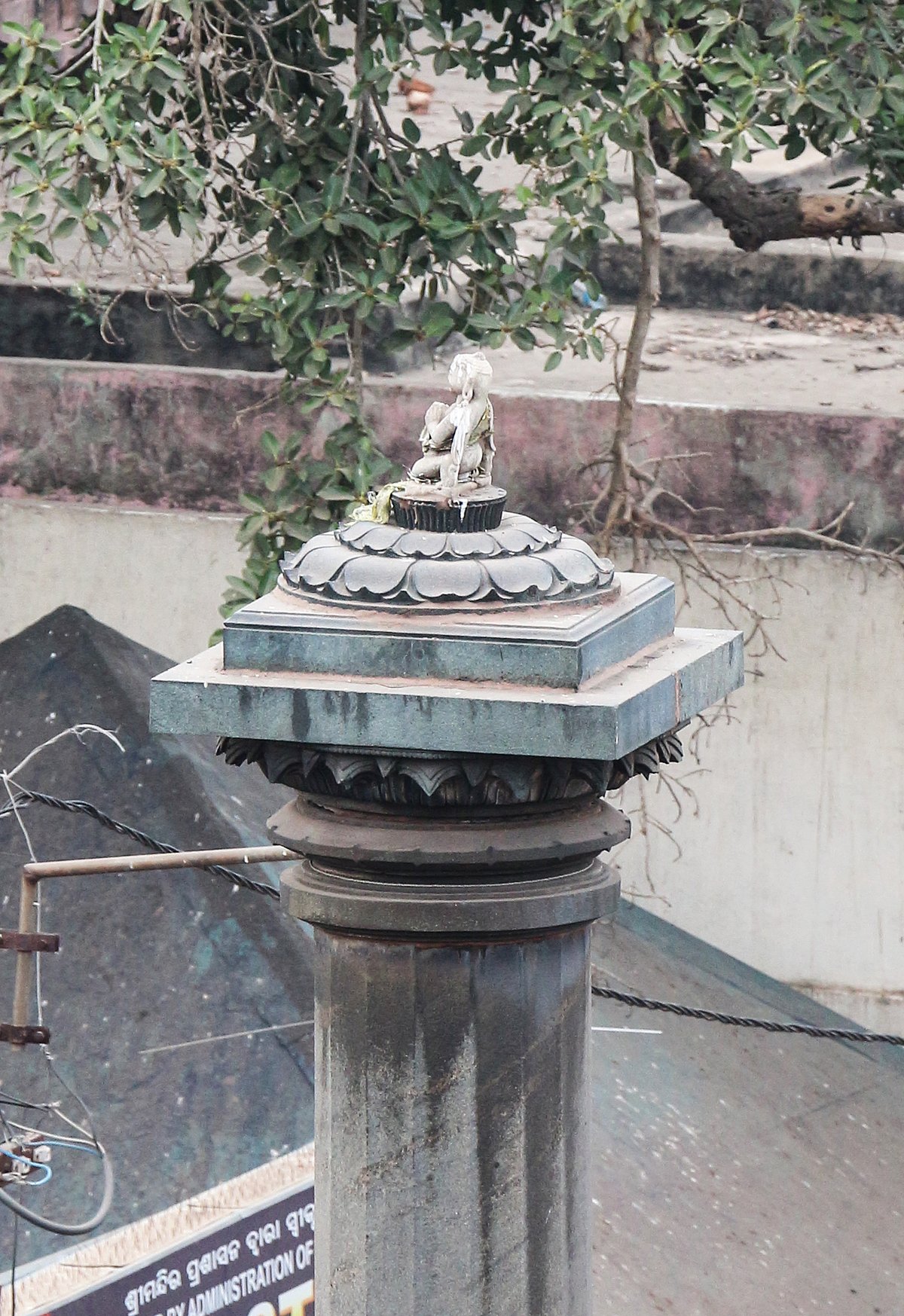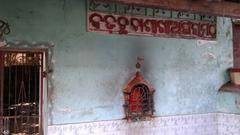
Visiting Aruna Stambha: Hours, Tickets, and Tips
Date: 01/08/2024
Introduction
The Aruna Stambha, also known as the Sun Pillar, is a towering monolithic column situated in front of the Lion Gate (Singhadwara) of the Jagannath Temple in Puri, Odisha. Standing at an impressive height of 34 feet (10.5 meters), this sixteen-sided chlorite stone pillar is crowned with an idol of Aruna, the charioteer of the Sun God, Surya, depicted in a praying posture (Wikipedia). The Aruna Stambha was originally constructed during the 13th century by the Ganga dynasty, specifically under King Langula Narasingha Deva, and was initially installed at the Sun Temple in Konark. Due to significant damage to the Sun Temple during the 15th and 16th centuries, the pillar was relocated to the Jagannath Temple in Puri in the late 18th century to ensure its preservation (Navrang India). This relocation was carried out during the reign of Bhoi King Dibyasingha Deva II, with significant efforts from the Maratha guru Brahmachari Gosain (Jagannath Sanskruti).
The Aruna Stambha is not only a historical monument but also holds immense religious significance. It is intricately carved with military scenes and other figures, showcasing the artistic skills of the period. The pillar’s presence at the entrance of the Jagannath Temple serves as a symbolic connection between the Sun God and Lord Jagannath, reinforcing the spiritual and cultural ties between the two deities (Hindu Blog). The pillar attracts thousands of devotees and tourists annually, who come to admire its architectural brilliance and seek blessings from the Sun God (TripSavvy). This guide provides a comprehensive look at the history, architectural and religious significance, as well as essential visitor information, ensuring a memorable visit to this iconic structure.
Table of Contents
- Historical Background
- Architectural Features
- Rituals and Significance
- Visitor Information
- Travel Tips
- Nearby Attractions
- Accessibility
- Preservation and Current Status
- FAQ
Historical Background
Origins and Construction
The construction of the Aruna Stambha dates back to the 13th century during the reign of the Ganga dynasty, specifically under King Langula Narasingha Deva. Initially, the pillar was erected at the Sun Temple in Konark, another architectural marvel of Odisha. The Sun Temple, a UNESCO World Heritage Site, faced significant damage during the 15th and 16th centuries due to invasions, leading to the abandonment of the site (Navrang India).
Relocation to Puri
The relocation of the Aruna Stambha from Konark to Puri occurred in the late 18th century. According to the Madala Panji, the chronicle of the Jagannath Temple, the pillar was moved during the reign of Bhoi King Dibyasingha Deva II. The Maratha guru Brahmachari Gosain played a pivotal role in this relocation, ensuring the pillar’s preservation and continued reverence (Wikipedia).
The decision to move the Aruna Stambha to Puri was influenced by the deteriorating condition of the Konark Sun Temple and the need to protect this significant artifact. The pillar was installed in front of the Singhadwara of the Jagannath Temple, aligning with the Vedic tradition that equates Surya (the Sun God) with Vishnu, making it appropriate to place the Sun Pillar in front of a Vishnu temple (Jagannath Sanskruti).
Architectural Features
The Aruna Stambha is renowned for its exquisite craftsmanship and intricate carvings. The base of the pillar is adorned with military scenes and various other figures, showcasing the artistic skills of the period. The capital of the pillar is decorated with a series of lotus petals, adding to its aesthetic appeal (Hindu Blog).
The monolithic nature of the pillar, carved from a single piece of chlorite stone, highlights the advanced stone-working techniques of the time. The sixteen-sided shaft of the pillar is a testament to the precision and skill of the artisans who crafted it. The idol of Aruna at the top, with folded hands in a gesture of supplication, adds a spiritual dimension to the monument (Navrang India).
Rituals and Significance
The Aruna Stambha holds immense religious significance for the devotees visiting the Jagannath Temple. Daily rituals and pujas are performed at the pillar by the Chunara or Garuda Sevaks of the temple, following Vedic traditions. Devotees also offer their prayers to the idol of Aruna, seeking blessings from the Sun God (Jagannath Sanskruti).
The pillar’s presence at the entrance of the Jagannath Temple serves as a symbolic connection between the Sun God and Lord Jagannath, reinforcing the spiritual and cultural ties between the two deities. The Aruna Stambha is not only a historical monument but also a living symbol of devotion and reverence for the divine (Navrang India).
Visitor Information
Visiting Hours
The Aruna Stambha can be visited during the same hours as the Jagannath Temple. Generally, the temple is open from early morning (around 5:00 AM) to late evening (around 10:00 PM). However, it’s advisable to check the current visiting hours before planning your visit.
Tickets
There is no separate ticket required to visit the Aruna Stambha, as it is part of the Jagannath Temple complex. However, donations are always welcome and appreciated to support the temple’s maintenance.
Best Visiting Times
The best times to visit are during early morning and late evening hours to avoid the heat and the crowd. Visiting during major festivals like Rath Yatra can provide a unique cultural experience but may also result in larger crowds.
Travel Tips
- How to Get There: Puri is well-connected by road, rail, and air. The nearest airport is Biju Patnaik International Airport in Bhubaneswar, about 60 km away. Puri Railway Station is well-connected to major cities in India.
- What to Wear: Modest attire is recommended when visiting the temple. Avoid wearing shorts or sleeveless tops.
- Best Times to Visit: October to February is the best time to visit Puri due to the pleasant weather.
Nearby Attractions
- Jagannath Temple: A major pilgrimage site for Hindus, located right next to the Aruna Stambha.
- Puri Beach: A serene and picturesque beach ideal for relaxation.
- Konark Sun Temple: Another UNESCO World Heritage Site, located about 35 km from Puri.
- Chilika Lake: Asia’s largest brackish water lagoon, located about 50 km from Puri.
Accessibility
The Jagannath Temple complex, including the Aruna Stambha, is relatively accessible. However, the area can get crowded, which may pose challenges for people with disabilities. Wheelchair access is limited but efforts are being made to improve accessibility.
Preservation and Current Status
In recent years, efforts have been made to preserve the Aruna Stambha and ensure its protection. The pillar is now surrounded by iron grills to safeguard it from potential damage and vandalism. This measure also helps in managing the large number of devotees and tourists who visit the site daily (Jagannath Sanskruti).
The historical and cultural significance of the Aruna Stambha continues to attract scholars, historians, and tourists from around the world. Its intricate carvings and architectural brilliance offer a glimpse into the rich heritage of Odisha and the advanced craftsmanship of the 13th century (Wikipedia).
FAQ
- What are the visiting hours for Aruna Stambha? The visiting hours are generally from 5:00 AM to 10:00 PM, aligning with the Jagannath Temple’s hours.
- How much are the tickets for Aruna Stambha? There are no separate tickets required; entry is free as part of the Jagannath Temple complex.
- Is Aruna Stambha accessible for people with disabilities? The area can be crowded, which may pose challenges, but efforts are being made to improve accessibility.
Conclusion
The Aruna Stambha stands as a testament to the rich cultural and historical legacy of Odisha. From its origins at the Sun Temple in Konark to its relocation to the Jagannath Temple in Puri, the pillar has witnessed centuries of devotion and reverence. Its architectural beauty and spiritual significance continue to inspire awe and admiration among all who visit this sacred site. The preservation efforts ensure that the Aruna Stambha remains a cherished monument for future generations to appreciate and revere.
References
- Wikipedia. (2024). Aruna Stambha. Retrieved from https://en.wikipedia.org/wiki/Aruna_Stambha
- Navrang India. (2024). Jagannath Temple Puri and Aruna Stambha. Retrieved from http://www.navrangindia.in/2024/01/jagannath-temple-puri-and-aruna-stambha.html
- Jagannath Sanskruti. (2024). Aruna Stambha: Sun Pillar of Jagannath Temple. Retrieved from https://jagannathsanskruti.com/aruna-stambha-sun-pillar-of-jagannath-temple/
- Hindu Blog. (2018, July). Aruna Stambha in front of Puri. Retrieved from https://www.hindu-blog.com/2018/07/aruna-stambha-in-front-of-puri.html
- TripSavvy. (2024). Puri Jagannath Temple Visitor’s Guide. Retrieved from https://www.tripsavvy.com/puri-jagannath-temple-visitors-guide-1539702
- FabHotels. (2024). Konark Sun Temple Puri. Retrieved from https://www.fabhotels.com/blog/konark-sun-temple-puri/

